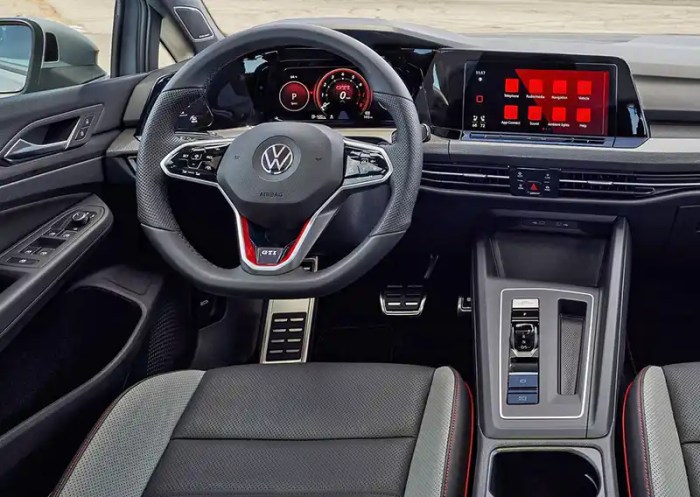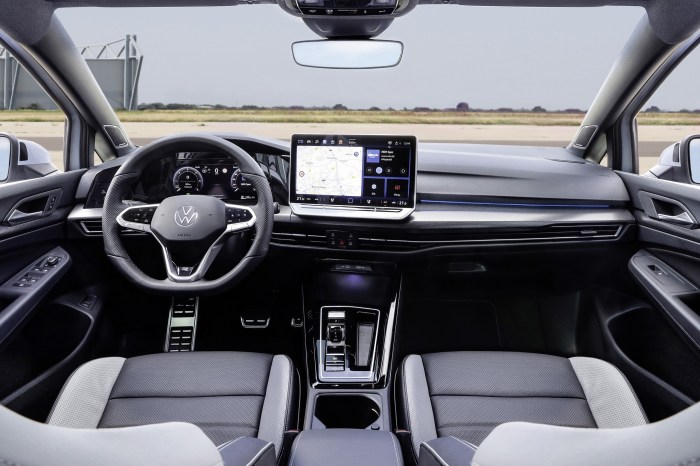While the VW e-Golf is no longer in production, exploring its interior design and technology offers valuable insights into the evolution of electric vehicle interiors and provides a useful benchmark for comparing current and future models. This article delves into the features that made the e-Golf’s cabin a noteworthy space, focusing on its design philosophy, technological integrations, and overall user experience.
We’ll explore aspects relevant even for prospective buyers considering similar EVs today.
A Modern and Minimalist Cabin: Design Philosophy
The e-Golf’s interior prioritized a clean, minimalist aesthetic. This wasn’t just about visual appeal; it also contributed to a sense of spaciousness and ease of use. The dashboard, for example, avoided clutter, integrating key controls seamlessly into a streamlined design. The focus was on functionality and driver ergonomics, making the driving experience intuitive and enjoyable. The use of high-quality materials, such as soft-touch plastics and premium upholstery options (depending on trim level), further enhanced the premium feel of the cabin.
Material Choices and Build Quality
Volkswagen, known for its build quality, ensured the e-Golf’s interior felt durable and well-assembled. The choice of materials, while aiming for a balance between cost-effectiveness and premium feel, contributed to a cabin that felt both modern and robust. The tactile experience of interacting with the controls and surfaces was generally well-received by reviewers.
Ergonomics and Driver-Centric Design
The e-Golf’s driver-focused layout placed frequently used controls within easy reach. The steering wheel, instrument cluster, and infotainment screen were positioned for optimal visibility and accessibility. This design philosophy minimized driver distraction, enhancing both safety and the overall driving experience. The seating position, too, was generally praised for its comfort and support.
Technology Features: A Blend of Simplicity and Innovation
The e-Golf’s technology wasn’t about overwhelming the driver with features; instead, it focused on integrating useful technologies seamlessly into the driving experience. This approach ensured ease of use and minimized distractions.
Infotainment System and Connectivity
The e-Golf featured a touchscreen infotainment system, offering access to navigation, media playback, and smartphone integration via Apple CarPlay and Android Auto. While the screen size might seem modest by today’s standards, its responsiveness and intuitive interface were generally well-regarded. The system’s integration with the car’s other features, such as climate control and driving settings, created a cohesive user experience.
Driver Assistance Systems
Depending on the trim level, the e-Golf offered various driver-assistance features, including adaptive cruise control, lane keeping assist, and automatic emergency braking. These systems enhanced safety and contributed to a more relaxed driving experience, particularly during long journeys. While not as extensive as the driver-assistance suites found in some newer EVs, the features included were generally effective and well-integrated.
Instrumentation and Displays
The e-Golf’s instrument cluster provided clear and concise information to the driver. The digital display showed speed, range, battery level, and other essential data in a highly readable format. The design was uncluttered and easy to understand, minimizing distractions and ensuring that critical information was readily accessible.
Comparing the e-Golf’s Interior to Competitors
Compared to other EVs of its time, the e-Golf’s interior offered a compelling blend of practicality, technology, and design. While some competitors might have boasted larger screens or more advanced driver-assistance systems, the e-Golf’s focus on a user-friendly and well-integrated experience made it a strong contender in its segment. Its minimalist design, however, might not appeal to everyone, especially those who prefer a more visually stimulating cabin.
Sustainability and Eco-Friendly Materials
While specific details on the exact materials used in the e-Golf’s interior are not readily available across all trim levels, Volkswagen made a commitment to using recycled and sustainable materials wherever possible. This aligned with the overall ethos of an electric vehicle, aiming to minimize the environmental impact of the vehicle’s production and lifecycle.

Source: burlappcar.com
Frequently Asked Questions (FAQ)
- Q: Was the e-Golf’s interior spacious? A: Yes, the e-Golf offered surprisingly spacious cabin for its class, particularly in the rear passenger area. The minimalist design helped to maximize interior space.
- Q: What kind of materials were used in the e-Golf’s interior? A: The e-Golf used a combination of soft-touch plastics, cloth upholstery (with leather options available on higher trims), and other materials designed for durability and a premium feel.
- Q: Did the e-Golf have a sunroof? A: A panoramic sunroof was available as an option on some trim levels.
- Q: How was the infotainment system? A: The infotainment system was generally well-regarded for its ease of use and intuitive interface, offering Apple CarPlay and Android Auto integration.
- Q: What driver-assistance features were available? A: Features varied by trim level but could include adaptive cruise control, lane keeping assist, and automatic emergency braking.
Conclusion
The VW e-Golf’s interior design and technology represented a balanced approach, prioritizing user experience and functionality over flashy features. Its minimalist design, focus on ergonomics, and well-integrated technology created a pleasant and efficient driving environment. While no longer in production, understanding its strengths and weaknesses provides valuable context for assessing current and future electric vehicle offerings.
Call to Action
Interested in learning more about the evolution of electric vehicle interiors? Explore reviews and comparisons of current electric vehicles to see how the industry has advanced since the e-Golf. Consider researching current VW models and their technological advancements to witness the progression in design and functionality.
FAQ Summary
Will the 2025 e-Golf have a redesigned dashboard?
While specifics are unavailable, a refreshed dashboard design incorporating a larger touchscreen and potentially a digital instrument cluster is highly probable given industry trends.

Source: autoevolution.com
What new driver-assistance features are anticipated?
Expect advancements in existing features like adaptive cruise control and lane-keeping assist, possibly including enhanced autonomous driving capabilities or new driver-monitoring systems.
Will sustainable materials be used in the interior?
Volkswagen has publicly committed to using more sustainable materials in its vehicles, so expect to see recycled fabrics, vegan leather alternatives, or other eco-conscious choices in the 2025 e-Golf’s interior.
What about the infotainment system upgrades?
A larger, more responsive touchscreen with improved software and potentially wireless Apple CarPlay/Android Auto integration is anticipated. Voice control enhancements are also likely.
